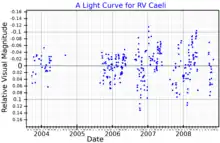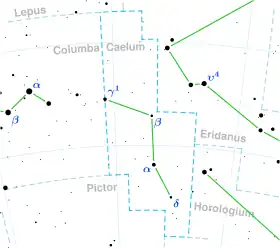RV Caeli
RV Caeli, also known as HD 28552, is a solitary, red hued variable star located in the southern constellation Caelum, the chisel. It has an apparent magnitude of 6.4,[2] placing it near the limit for naked eye visibility. The object is located relatively far at a distance of 1,340 light years based on parallax measurements from Gaia DR3,[1] but is rapidly receding with a heliocentric radial velocity of 98 km/s.[7]

 | |
| Observation data Epoch J2000 Equinox J2000 | |
|---|---|
| Constellation | Caelum |
| Right ascension | 04h 28m 09.46368s[1] |
| Declination | −41° 51′ 35.4013″[1] |
| Apparent magnitude (V) | 6.4±0.01[2] |
| Characteristics | |
| Evolutionary stage | AGB[3] |
| Spectral type | M1 III[4] |
| B−V color index | +1.64[5] |
| Variable type | semiregular[6] |
| Astrometry | |
| Radial velocity (Rv) | 97.9±0.5[7] km/s |
| Proper motion (μ) | RA: −14.75 mas/yr[8] Dec.: +2.87 mas/yr[8] |
| Parallax (π) | 2.4402 ± 0.0229 mas[1] |
| Distance | 1,340 ± 10 ly (410 ± 4 pc) |
| Absolute magnitude (MV) | −1.36[9] |
| Details | |
| Mass | 1.14[10] M☉ |
| Radius | 107[11] R☉ |
| Luminosity | 976±30[12] L☉ |
| Surface gravity (log g) | 0.67[10] cgs |
| Temperature | 3,843±122[13] K |
| Metallicity [Fe/H] | −0.15[10] dex |
| Other designations | |
| Database references | |
| SIMBAD | data |
Hipparcos has found it to vary between its photometric values of 6.44 and 6.56,[6] which roughly corresponds with the magnitude as seen with the naked eye. It was first suspected of variability in 1970,[17] and a 1982 survey also identified suspected variations. However, it could not confirm it was a variable star..[18] It was confirmed as a variable star in 1999 on the basis of the Hipparcos photometry and given the variable star designation RV Caeli.[19]
RV Caeli is an evolved red giant star with a stellar classification of M1 III.[4] It is currently on the asymptotic giant branch,[3] generating energy via hydrogen and helium shell fusion around an inert carbon core. It has 114% the mass of the Sun[10] but has expanded to over 100 times its girth.[11] It radiates 976 times the luminosity of the Sun[12] from its photosphere at an effective temperature of 3,843 K.[13] RV Caeli is metal deficient, having an iron abundance 70% that of the Sun.
References
- Vallenari, A.; et al. (Gaia collaboration) (2023). "Gaia Data Release 3. Summary of the content and survey properties". Astronomy and Astrophysics. 674: A1. arXiv:2208.00211. Bibcode:2023A&A...674A...1G. doi:10.1051/0004-6361/202243940. S2CID 244398875. Gaia DR3 record for this source at VizieR.
- Høg, E.; Fabricius, C.; Makarov, V. V.; Urban, S.; Corbin, T.; Wycoff, G.; Bastian, U.; Schwekendiek, P.; Wicenec, A. (March 2000). "The Tycho-2 catalogue of the 2.5 million brightest stars". Astronomy and Astrophysics. 355: L27–L30. Bibcode:2000A&A...355L..27H. ISSN 0004-6361.
- Eggen, Olin J. (July 1992). "Asymptotic giant branch stars near the sun". The Astronomical Journal. 104: 275. Bibcode:1992AJ....104..275E. doi:10.1086/116239. ISSN 0004-6256.
- Houk, Nancy (1978). Michigan catalogue of two-dimensional spectral types for the HD stars Volume II: Declinations −52° to −41°. Bibcode:1978mcts.book.....H.
- Johnson, H. L.; Mitchell, R. I.; Iriarte, B.; Wisniewski, W. Z. (1966). "UBVRIJKL Photometry of the Bright Stars". Communications of the Lunar and Planetary Laboratory. 4: 99–110. Bibcode:1966CoLPL...4...99J.
- VSX (25 August 2009). "RV Cae". International Variable Star Index. American Association of Variable Star Observers. Retrieved 30 June 2014.
- Gontcharov, G. A. (November 2006). "Pulkovo Compilation of Radial Velocities for 35,495 Hipparcos stars in a common system". Astronomy Letters. 32 (11): 759–771. arXiv:1606.08053. Bibcode:2006AstL...32..759G. doi:10.1134/S1063773706110065. eISSN 1562-6873. ISSN 1063-7737. S2CID 119231169.
- van Leeuwen, Floor (13 August 2007). "Validation of the new Hipparcos reduction". Astronomy & Astrophysics. 474 (2): 653–664. arXiv:0708.1752. Bibcode:2007A&A...474..653V. doi:10.1051/0004-6361:20078357. eISSN 1432-0746. ISSN 0004-6361. Hipparcos record for this source at VizieR.
- Anderson, E.; Francis, Ch. (May 2012). "XHIP: An extended hipparcos compilation". Astronomy Letters. 38 (5): 331–346. arXiv:1108.4971. Bibcode:2012AstL...38..331A. doi:10.1134/S1063773712050015. eISSN 1562-6873. ISSN 1063-7737. S2CID 119257644.
- Anders, F.; et al. (August 2019). "Photo-astrometric distances, extinctions, and astrophysical parameters for Gaia DR2 stars brighter than G = 18". Astronomy & Astrophysics. 628: A94. arXiv:1904.11302. Bibcode:2019A&A...628A..94A. doi:10.1051/0004-6361/201935765. eISSN 1432-0746. ISSN 0004-6361.
- Kervella, Pierre; Arenou, Frédéric; Thévenin, Frédéric (2022). "Stellar and substellar companions from Gaia EDR3". Astronomy & Astrophysics. 657: A7. arXiv:2109.10912. Bibcode:2022A&A...657A...7K. doi:10.1051/0004-6361/202142146. eISSN 1432-0746. ISSN 0004-6361.
- Brown, A. G. A.; et al. (Gaia collaboration) (August 2018). "Gaia Data Release 2: Summary of the contents and survey properties". Astronomy & Astrophysics. 616. A1. arXiv:1804.09365. Bibcode:2018A&A...616A...1G. doi:10.1051/0004-6361/201833051. Gaia DR2 record for this source at VizieR.
- Stassun, Keivan G.; et al. (9 September 2019). "The Revised TESS Input Catalog and Candidate Target List". The Astronomical Journal. 158 (4): 138. arXiv:1905.10694. Bibcode:2019AJ....158..138S. doi:10.3847/1538-3881/ab3467. eISSN 1538-3881.
- Gould, Benjamin Apthorp (1878). "Uranometria Argentina : brillantez y posicion de las estrellas fijas, hasta la septima magnitud, comprendidas dentro de cien grados del polo austral : con atlas". Resultados del Observatorio Nacional Argentino. 1. Bibcode:1879RNAO....1.....G.
- "HD 28552". SIMBAD. Centre de données astronomiques de Strasbourg. Retrieved September 28, 2022.
- Tabur, V.; Bedding, T. R.; Kiss, L. L.; Moon, T. T.; Szeidl, B.; Kjeldsen, H. (December 2009). "Long-term photometry and periods for 261 nearby pulsating M giants". Monthly Notices of the Royal Astronomical Society. 400 (4): 1945–1961. arXiv:0908.3228. Bibcode:2009MNRAS.400.1945T. doi:10.1111/j.1365-2966.2009.15588.x. S2CID 15358380.
- Eggen, O. J.; Stokes, N. R. (July 1970). "Narrow-Band and Broad-Band Photometry of Red Stars. III. Southern Giants". The Astrophysical Journal. 161: 199. Bibcode:1970ApJ...161..199E. doi:10.1086/150525. eISSN 1538-4357. ISSN 0004-637X.
- Rufener, F.; Bartholdi, P. (June 1982). "List of 333 variable, microvariable or suspected variable stars detected in the Geneva photometry". Astronomy and Astrophysics Supplement Series. 48: 503. Bibcode:1982A&AS...48..503R.
- Kazarovets, E. V.; Samus, N. N.; Durlevich, O. V.; Frolov, M. S.; Antipin, S. V.; Kireeva, N. N.; Pastukhova, E. N. (January 1999). "The 74th Special Name-list of Variable Stars". Information Bulletin on Variable Stars. 4659: 1. Bibcode:1999IBVS.4659....1K. ISSN 0374-0676.